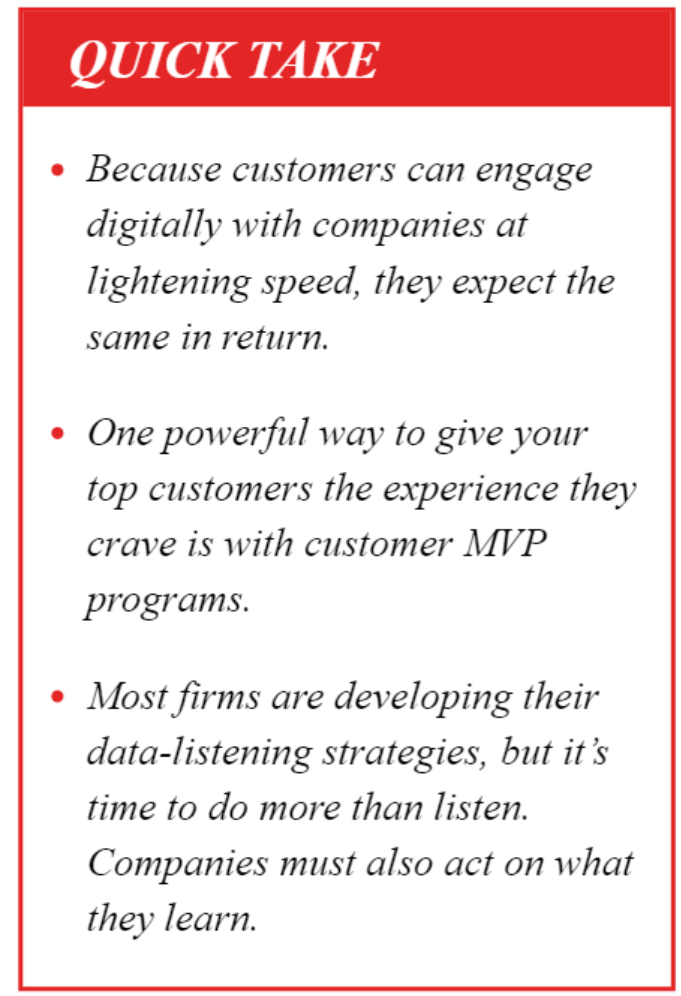Originally published on CMO.com on July 6, 2017
Ask any CMO worth her salt to demonstrate her value, and she’ll point to customer retention.
That’s because for most organizations, customer retention is the very definition of competitive advantage. And finding ways to get closer to customers, and keep them close for the long haul, is the Holy Grail.
But retaining customers is easier said than done. Customers are a demanding and sophisticated group with high expectations of the firms with whom they do business. They have specific ideas about the products and services they use—and they want a response when they make suggestions.
Plus, because they can engage digitally with companies at lightening speed, they expect the same in return. I’m not talking about tweeting them back about their complaints or emailing them to say thank you for their input. I’m talking about delivering a customized experience that pulls them in and keeps them coming back for more.
Thankfully, there are several digital strategies you can use to put the golden cup within reach:
1. Don’t Treat All Customers Equally
When digital solutions became mainstream, most companies responded with tools and programs that welcomed all of their customers and made it possible for them to listen and comment online.
But not all customers are created equal—and universal access didn’t translate into increased sales. Companies now realize that hand-picking select champions and giving them a differentiated experience has a greater yield.
One powerful way to give your top customers the experience they crave is with customer MVP programs and customer advisory boards. For example, SAP runs a vibrant SAP mentors community in which 160 bloggers, consultants, and technical wizards share their experiences and co-create with the company. (Disclosure: SAP is a Leader Networks client.)
SAP mentors are the most influential community participants in the SAP ecosystem. SAP recognizes their contributions by connecting them with its executives, calling on them to shape project roadmaps, and giving them special status at events.
It’s a shared-valued model: SAP mentors have a hand in creating the future products and services they want to use. SAP benefits from the wisdom and insight of its most accomplished users.
Does this mutually beneficial relationship drive customer loyalty and retention? You bet.
2. Tell Them It’s Personal
Organizations have access to massive amounts of data on every digital user. These data stores, when coupled with analytics, can yield a treasure trove of inspiration to give customers the personal experience they covet.
Most firms are just starting to develop their data-listening strategies, but it’s time to do more than listen. Companies must also act on what they learn.
That’s something Rosetta Stone does very well. The company has implemented a customer-centric environment that supports its mantra of listening to customers. On the company’s website, prospective customers self-select their experience based on their goals and receive increasingly customized content with every personal disclosure.
Returning customers also receive highly personalized content, service offers, and promotions based on their product use and level of support. The takeaway? Listen, respond, and personalize. Then watch as these personalization efforts lead to greater loyalty, increased retention, and more revenue when you get the formula right.
3. Make It A Team Sport
Sometimes delivering the best possible experience to your customers means joining forces with other organizations. In other words, form a digital ecosystem. Gartner defines a digital ecosystem as “an interdependent group of enterprises, people, and/or things that share standardized digital platforms for a mutually beneficial purpose.”
Case in point: The Siemens Healthineers Digital Ecosystem, powered by global conglomerate Siemens. Siemens Healthineers is building the digital ecosystem to connect a broad range of partners and enable them to deliver clinical and operational patient data to healthcare providers in a secure and collaborative way. The ecosystem is a win-win for partners and customers alike.
But guess who else wins in the competitive advantage category? That’s right–Siemens Healthineers.
When done right, digital strategies change business as usual for the better. These strategies enable you to vastly improve the experience for current and prospective customers, which drives greater intimacy and retention.
Of course, it doesn’t happen overnight. Creating an integrated digital strategy involves big organizational changes and some heavy lifting. After all, you’ll be changing processes, not just practices and perspectives.
But when the outcome is a better customer experience that leads to competitive advantage, a digital strategy isn’t an evolution. It’s an imperative.



